Craftsman 137.21221 User Manual
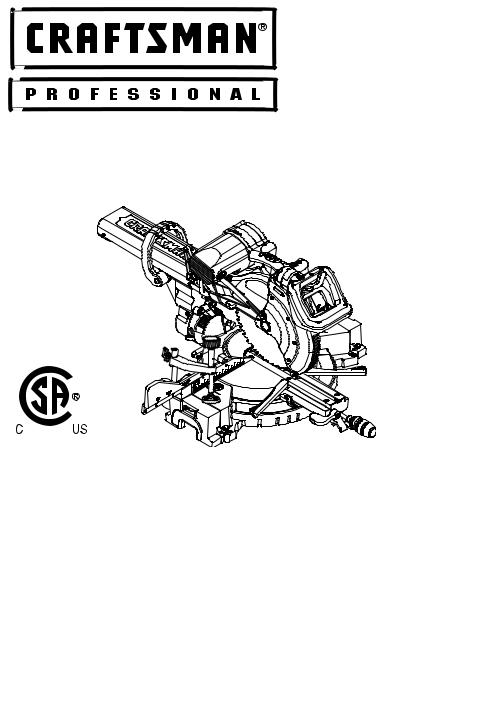
Operator’s Manual
12in.DUALBEVELSLIDINGCOMPOUND MITERSAWWITHLASERTRAC®
ModelNo.137.212210
CAUTION:
Before using this Miter Saw, read this manual and follow all its Safety Rules and Operating Instructions
●Safety Instructions
●Installation
●Operation
●Maintenance
●Parts List
Customer Help Line |
|
Sears Parts & |
For Technical Support |
|
Repair Center |
1-800-843-1682 |
|
1-800-488-1222 |
Sears, Roebuck and Co., Hoffman Estates, lL 60179 USA |
|
Visit our Craftsman website: www.sears.com/craftsman |
|
Part No. 137212210001 |
Printed in Taiwan |

TABLE OF CONTENTS |
|
SECTION |
PAGE |
Warranty ............................................................................................. |
2 |
Product Specifications ........................................................................ |
3 |
Symbols.............................................................................................. |
4 |
Power Tool Safety .............................................................................. |
5 |
Compound Miter Saw Safety .............................................................. |
7 |
Electrical Requirements and Safety...................................................... |
9 |
Accessories and Attachments ............................................................ |
11 |
Tools Needed for Assembly ................................................................ |
12 |
Carton Contents ................................................................................. |
13 |
Know Your Compound Miter Saw........ ................................................ |
14 |
Glossary of Terms .............................................................................. |
15 |
Assembly and Adjustments ................................................................ |
17 |
Operation ........................................................................................... |
30 |
Maintenance ....................................................................................... |
44 |
Troubleshooting Guide ....................................................................... |
46 |
Parts List ............................................................................................. |
48 |
WARRANTY |
|
CRAFTSMAN ONE YEAR FULL WARRANTY
If this Craftsman tool fails due to a defect in material or workmanship within one year from the date of purchase, call 1-800-4-MY-HOME® to arrange for free repair (or replacement if repair proves impossible).
This warranty applies for only 90 days from the date of purchase if this product is ever used for commercial or rental purposes.
This warranty does not include expendable parts, such as lamps, batteries, bits or blades.
This warranty gives you specific legal rights, and you may also have other rights which vary from state to state.
Sears, Roebuck and Co., Hoffman Estates, IL 60179
! WARNING
Some dust created by using power tools contains chemicals known to the state of California to cause cancer and birth defects or other reproductive harm. Some examples of these chemicals are:
●Lead from lead-based paints
●Crystalline silica from bricks, cement and other masonry products
●Arsenic and chromium from chemically treated lumber
Your risk from these exposures varies, depending on how often you do this type of work. To reduce your exposure to these chemicals, work in a well ventilated area and work with approved safety equipment such as dust masks that are specially designed to filter out microscopic particles.
2
2008/04
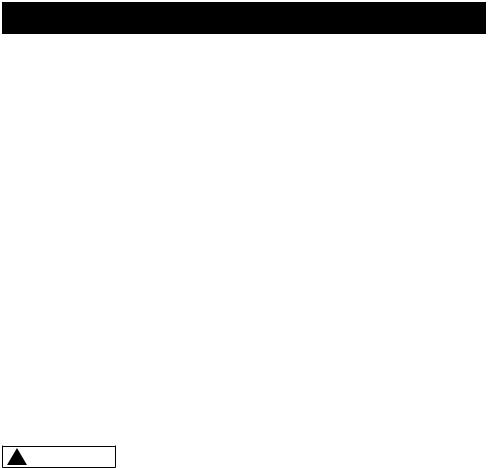
PRODUCT SPECIFICATIONS
MOTOR |
|
Power Source ............................... |
120VAC,60Hz,15Amp |
Speed ........................................... |
4200 RPM (No load) |
Brake ............................................ |
Electric |
Double Insulated ........................... |
Yes |
Motor Arbor Shaft Size .................. |
5/8 in. |
BLADE SIZE |
|
Diameter ....................................... |
12 in. |
Arbor size ...................................... |
1in.w/a5/8in.reducer |
ROTATING TABLE |
|
Diameter ....................................... |
13-7/16 in. |
Miter Detent Stops ........................ |
0, 15, 22.5, 31.6, 45ºR & L, 60º R |
Bevel Positive Stops ..................... |
0, 33.9, 45º R & L |
CUTTING CAPACITY |
|
Crosscut ........................................ |
4 in. x 12-1/4 in. |
Miter 45° R & L; 60º R .................... |
4 in. x 8-3/4 in. R & L ; 4 in. x 6-1/4 in. R |
Bevel 45º R & L ............................. |
2-1/2 in. x 12-1/4 in. L ; 1-3/4 in. x 12-1/4 in. R |
45° Miter and 45° Bevel R & L........ |
2-1/2 in. x 8-3/4 in. |
60º Miter and 45º Bevel R .............. |
1-3/4 in. x 6-1/4 in. |
! WARNING
To avoid electrical hazards, fire hazards or damage to the tool, use proper circuit protection.
This tool is wired at the factory for 110-120 Volt operation. It must be connected to a 110-120 Volt / 15 Ampere time delay fuse or circuit breaker. To avoid shock or fire, replace power cord immediately if it is worn, cut or damaged in any way.
Before using your tool, it is critical that you read and understand these safety rules. Failure to follow these rules could result in serious injury to you or damage to the tool.
 3
3 
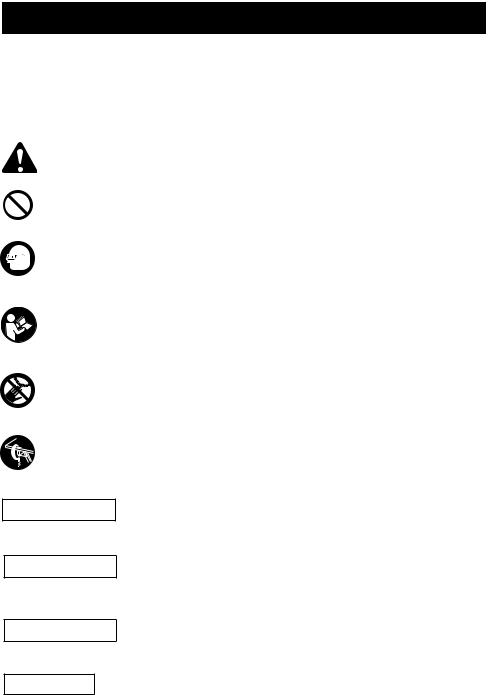
SYMBOLS
WARNING ICONS
Your power tool and its Operator’s Manual may contain “WARNING ICONS” (a picture symbol intended to alert you to, and/or instruct you how to avoid, a potentially hazardous condition). Understanding and heeding these symbols will help you operate your tool better and safer. Shown below are some of the symbols you may see.
SAFETY ALERT: Precautions that involve your safety.
PROHIBITION
WEAR EYE PROTECTION: Always wear safety goggles or safety glasses with side shields.
READ AND UNDERSTAND OPERATOR’S MANUAL: To reduce the risk of injury, user and all bystanders must read and understand operator’s manual before using this product.
KEEP HANDS AWAY FROM BLADE: Failure to keep your hands away from the blade will result in serious personal injury.
SUPPORT AND CLAMP WORK
! DANGER
! WARNING
! CAUTION
CAUTION
DANGER: indicates an imminently hazardous situation which, if not avoided, will result in death or serious injury.
WARNING: indicates a potentially hazardous situation which, if not avoided, could result in death or serious injury.
CAUTION: indicates a potentially hazardous situation which, if not avoided, may result in minor or moderate injury.
CAUTION: used without the safety alert symbol indicates a potentially hazardous situation which, if not avoided, may result in property damage.
 4
4 

POWER TOOL SAFETY
GENERAL SAFETY INSTRUCTIONS BEFORE USING THIS POWER TOOL
Safety is a combination of common sense, staying alert and knowing how to use your power tool.
CAUTION
To avoid mistakes that could cause serious injury, do not plug the tool in until you have read and understood the following.
1. READ and become familiar with the entire Operator’s
Manual. LEARN the tool’s application, limitations and possible hazards.
2.KEEP GUARDS IN PLACE and in working order.
3.REMOVE ADJUSTING KEYS AND WRENCHES. Form the habit of checking to see that keys and adjusting wrenches are removed from the tool before turning ON.
4.KEEP WORK AREA CLEAN. Cluttered areas and benches invite accidents.
5.DO NOT USE IN DANGEROUS ENVIRONMENTS. Do not use power tools in damp locations, or expose them to rain or snow. Keep work area well lit.
6.KEEP CHILDREN AWAY. All visitors and bystanders should be kept a safe distance from work area.
7.MAKE WORKSHOP CHILD PROOF with padlocks, master switches or by removing starter keys.
8.DO NOT FORCE THE TOOL. It will do the job better and safer at the rate for which it was designed.
9.USE THE RIGHT TOOL. Do not force the tool or an attachment to do a job for which it was not designed.
10.USE PROPER EXTENSION CORDS. Make sure your extension cord is in good condition. When using an extension cord, be sure to use one heavy enough to carry the current your product will draw. An undersized cord will result in
a drop in line voltage and in loss of power which will cause the tool to overheat. The table on page 10 shows the correct size to use depending on cord length and nameplate ampere rating. If in doubt, use the next heavier gauge.
The smaller the gauge number, the heavier the cord.
11.WEAR PROPER APPAREL. Do not wear loose clothing, gloves, neckties, rings, bracelets or other jewelry which may get caught in moving parts. Nonslip footwear is recommended. Wear protective hair covering to contain long hair.
12.ALWAYS WEAR EYE
PROTECTION. Any power tool can throw foreign objects into the eyes and
could cause permanent eye damage. ALWAYS wear Safety Goggles (not glasses) that comply with ANSI Safety standard Z87.1. Everyday eyeglasses have only impact–resistant lenses. They ARE NOT safety glasses. Safety Goggles are available at sears.
 5
5 

NOTE: Glasses or goggles not in compliance with ANSI Z87.1 could seriously injure you when they break.
13.WEAR A FACE MASK OR DUST MASK. Sawing operation produces dust.
14.SECURE WORK. Use clamps or a vise to hold work
 when practical. It is safer
when practical. It is safer 
 than using your hand and it frees both hands to operate the tool.
than using your hand and it frees both hands to operate the tool.
15.DISCONNECT TOOLS FROM POWER SOURCE before servicing, and when changing accessories such as blades, bits and cutters.
16.REDUCE THE RISK OF UNINTENTIONAL STARTING. Make sure switch is in the OFF position before plugging the tool in.
17.USE RECOMMENDED ACCESSORIES. Consult this Operator’s Manual for
recommended accessories. The use of improper accessories may cause risk of injury to yourself or others.
18.NEVER STAND ON THE TOOL. Serious injury could occur if the tool is tipped or if the cutting tool is unintentionally contacted.
19.CHECK FOR DAMAGED PARTS. Before further use of the tool, a guard or other part that is damaged should be carefully checked to determine that it will operate properly and perform its intended function – check for alignment of moving parts, binding of moving parts, breakage of parts, mounting
and any other conditions that may affect its operation. A guard or other part that is damaged should be properly repaired or replaced.
20.NEVER LEAVE THE TOOL RUNNING UNATTENDED. TURN THE POWER “OFF”. Do not walk away from a running tool until the blade comes to a complete stop and the tool is unplugged from the power source.
21.DO NOT OVERREACH. Keep proper footing and balance at all times.
22.MAINTAIN TOOLS WITH CARE. Keep tools sharp and clean for best and safest performance. Follow instructions for lubricating and changing accessories.
23.WARNING: Dust generated from certain materials can be hazardous to your health. Always operate saw in well-ventilated area and provide for proper dust removal.
24. |
|
DANGER |
People with |
|
|
! |
|
|
|
electronic devices, such as |
|
|
pacemakers, should consult their |
||
|
physician(s) before using this |
||
|
product. Operation of electrical |
||
|
equipment in close proximity to |
||
|
a heart pacemaker could cause |
||
|
interference or failure of the |
||
|
pacemaker. |
|
|
 6
6 

COMPOUND MITER SAW SAFETY
SPECIFIC SAFETY INSTRUCTIONS FOR THIS COMPOUND MITER SAW
1.DO NOT operate the miter saw until it is completely assembled and installed according to these instructions.
2.IF YOU ARE NOT thoroughly familiar with the operation of miter saws, seek guidance from your supervisor, instructor or other qualified person.
3.ALWAYS hold the work firmly against the fence and table. DO NOT perform any operation free hand (use clamp wherever possible).
4.KEEP HANDS out of the path of the saw blade. If the workpiece you are cutting would cause your hands to be within 8-3/4 in. of the saw blade, the workpiece should be clamped in place before making the cut.
5.BE SURE the blade is sharp, runs freely and is free of vibration.
6.ALLOW the motor to come up to full speed before starting a cut.
7.KEEP THE MOTOR AIR SLOTS CLEAN and free of chips or dust.
8.ALWAYS MAKE SURE all handles are tight before cutting, even if the table is positioned in one of the positive stops.
9.BE SURE both the blade and the collar are clean and the arbor bolt is tightened securely.
10.USE only blade collars specified for your saw.
11.NEVER use blades larger in diameter than 12 inches.
12.NEVER apply lubricants to the blade when it is running.
13.ALWAYS check the blade for cracks or damage before operation. Replace a cracked or damaged blade immediately.
14.NEVER use blades recommended for operation at less than 4200 RPM.
15.ALWAYS keep the blade guards in place and use at all times.
16.NEVER reach around the saw blade.
17.MAKE SURE the blade is not contacting the workpiece before the switch is turned ON.
18.IMPORTANT: After completing the cut, release the trigger and wait for the blade to stop before returning the saw to the raised position.
19.MAKE SURE the blade has come to a complete stop before removing or securing the workpiece, changing the workpiece angle or changing the angle of the blade.
20.NEVER cut metals or masonry products with this tool. This miter saw is designed for use on wood and wood-like products.
 7
7 
21.NEVER cut small pieces. If the workpiece being cut would cause your hand or fingers to be within 8-3/4 in. of the saw blade the workpiece is too small.
22.PROVIDE adequate support to the sides of the saw table for long work pieces.
23.NEVER use the miter saw in an area with flammable liquids or gases.
24.NEVER use solvents to clean plastic parts. Solvents could possibly dissolve or otherwise damage the material.
25.SHUT OFF the power before servicing or adjusting the tool.
26.DISCONNECT the saw from the power source and clean the machine when finished using.
27.MAKE SURE the work area is clean before leaving the machine.
28.SHOULD any part of your miter saw be missing, damaged, or fail in any way, or any electrical component fail to perform properly, lock the switch and remove the plug from the power supply outlet. Replace missing, damaged, or failed parts before resuming operation.
 8
8 
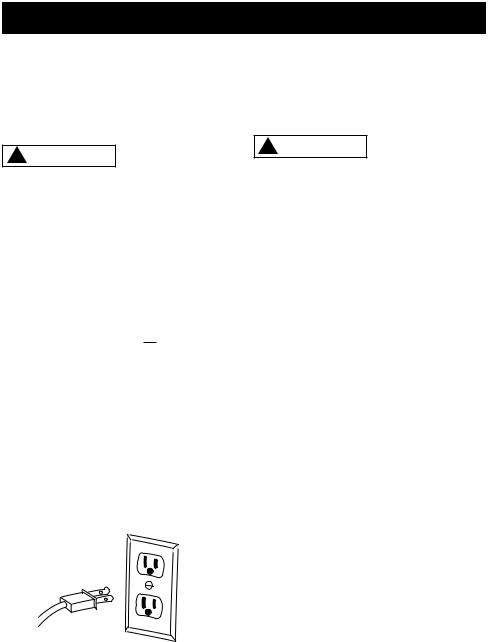
ELECTRICAL REQUIREMENTS AND SAFETY
POWER SUPPLY AND MOTOR SPECIFICATIONS
The AC motor used in this saw is a universal, nonreversible type. See “MOTOR” in the “PRODUCT
SPECIFICATIONS” section on page 3.
way. If the plug does not fit fully in the outlet, reverse the plug. If it still does not fit, contact a qualified electrician to install the proper outlet. Do not change the plug in any way.
! WARNING
To avoid electrical hazards, fire hazards, or damage to the tool, use proper circuit protection. Your saw is wired at the factory for 120 V operation. Connect to a 120 V, 15A circuit and use a 15 A time delay fuse or circuit breaker. To avoid shock or fire, if power cord is worn or cut, or damaged in any way, have it replaced immediately.
DOUBLE INSULATED 


The power tool is double insulated to provide a double thickness of insulation between you and tool’s electrical system. All exposed metal parts are isolated from the internal metal motor components with protecting insulation.
Replacement parts – When servicing, use only identical replacement parts.
Polarized plugs – This saw has a plug that looks like the one shown below:
To reduce the risk of electrical shock, this saw has a polarized plug (one blade is wider than the other). This plug will fit in a polarized outlet only one
! WARNING
Double insulation does not take the place of normal safety precautions when operating this tool.
To avoid electrocution:
1.Use only identical replacement parts when servicing a tool with double insulation. Servicing should be performed by a qualified technician.
2.Do not use power tools in wet or damp locations or expose them to rain or snow.
MOTOR SAFETY PROTECTION IMPORTANT
To avoid motor damage, the motor should be blown out or vacuumed frequently to keep sawdust from interfering with the motor ventilation.
1.Connect this saw to a 120 V circuit. This circuit must not be less than a #12 wire with a 20 A time lag fuse or a #14 wire with a 15 A time lag fuse. NOTE: When using an extension cord on a circuit with a #14 wire, the extension cord must not exceed 25 feet in length.
2.If the motor will not start, release the trigger switch immediately.
UNPLUG THE SAW. Check the saw blade to make sure it turns freely. If the blade is free, try to start the saw again. If the motor still does not start, refer to the TROUBLESHOOTING GUIDE.
3.If the tool suddenly stalls while cutting wood, release the trigger switch, unplug the tool and free the blade from the wood. The saw may
 9
9 

now be started and the cut finished.
4.FUSES may “blow” or circuit breakers may trip frequently if:
a.MOTOR is overloaded – overloading can occur if you feed too rapidly or make too many start/stops in a short time.
b.LINE VOLTAGE is more than 10% above or below the nameplate voltage rating. For
heavy loads, the voltage at motor terminals must equal the voltage specified on the nameplate.
c.IMPROPER or dull saw blades are used.
5.Most motor troubles may be traced to loose or incorrect connections, overload, low voltage or inadequate power supply wiring. Always check the connections, the load and supply circuit if the motor doesn’t run well. Check minimum gauge for the length of cord you are using on the chart below.
GUIDELINES FOR EXTENSION CORDS
Use a proper extension cord. Make sure your extension cord is in good condition. When using an extension cord, be sure to use one heavy enough to carry the current your product will draw. An undersized cord will cause
a drop in line voltage, resulting in loss of power and overheating. The table below shows the correct size to use depending on cord length and nameplate ampere rating. If in doubt, use the next heavier gauge. The
smaller the gauge number, the heavier the cord.
Be sure your extension cord is properly wired and in good condition. Always replace a damaged extension cord or have it repaired by a qualified person before using it. Protect your extension cords from sharp objects,
excessive heat and damp or wet areas.
Use a separate electrical circuit for your tools. This circuit must not be less than a #12 wire with a 20 A time lag fuse or a #14 wire with a 15 A time lag fuse. NOTE: When using an extension cord on a circuit with a #14 wire, the extension cord must not exceed 25 feet in length. Before connecting the tool to the power line, make sure the switch is in the OFF position and the electric current is
rated the same as the current stamped on the motor nameplate, running at a lower voltage will damage the motor.
MINIMUM GAUGE FOR EXTENSION CORDS (AWG)
(When using 120 volts only)
Ampere Rating |
|
Total length of Cord |
|||
More Than |
Not More Than |
25ft. |
50ft. |
100ft. |
150ft. |
0 |
6 |
18 |
16 |
16 |
14 |
|
|
|
|
|
|
6 |
10 |
18 |
16 |
14 |
12 |
|
|
|
|
|
|
10 |
12 |
16 |
16 |
14 |
12 |
12 |
16 |
14 |
12 |
Not Recommended |
|
CAUTION: In all cases make certain the receptacle in question is properly grounded. If you are not sure, have a certified electrician check the receptacle.
 10
10 
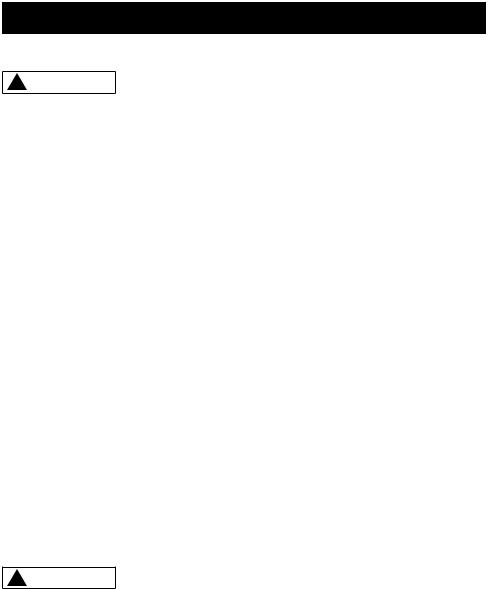
ACCESSORIES AND ATTACHMENTS
RECOMMENDED ACCESSORIES
!WARNING
●Use only accessories recommended for this miter saw. Follow instructions that accompany accessories. Use of improper accessories may cause hazards.
●The use of any cutting tool except 12 in. saw blades which meet the requirements under recommended accessories
is prohibited. Do not use accessories such as shaper cutters or dado sets. Ferrous metal cutting and the use of abrasive wheels is prohibited.
●Do not attempt to modify this tool or create accessories not recommended for use with this tool. Any such alteration or modification is misuse and could result in a hazardous condition leading to possible serious injury.
ACCESSORIES
Visit your Sears Hardware Department or see the Sears Power and Hand Tool Catalog to purchase recommended accessories for this power tool.
!WARNING
●To avoid the risk of personal injury, do not modify this power tool or use accessories not recommended by Sears.
●Read warnings and conditions on your CARBIDE TIPPED SAW BLADE. Do not operate the saw
without the proper saw blade guard in place. Carbide is a very hard but brittle material. Care should be taken while mounting, using, and storing carbide tipped blades to prevent accidental damage. Slight shocks, such as striking the tip while handling, can seriously damage the blade. Foreign objects in the workpiece, such as wire or nails, can also cause tips to crack or break off. Before using, always visually examine the blade and tips for bent blade, cracks, breakage, missing or loose tips, or other damage. Do not use if damage is suspected. Failure to heed safety instructions and warnings can result in serious bodily injury.
 11
11 
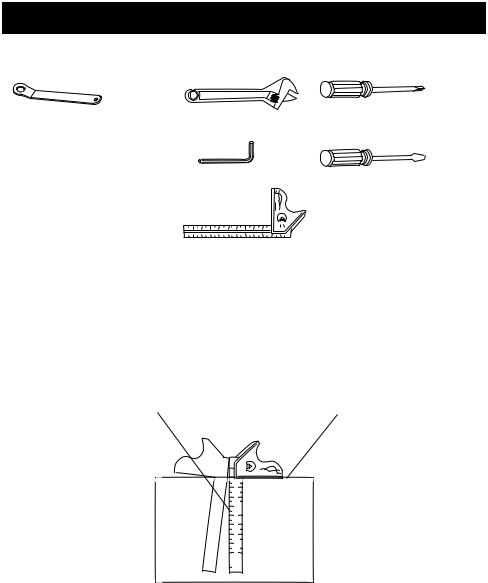
TOOLS NEEDED FOR ASSEMBLY
Supplied |
Not supplied |
|
Blade Wrench |
Adjustable Wrench |
Phillips Screwdriver |
|
6 mm Hex Wrench |
Slotted Screwdriver |
Combination Square
COMBINATION SQUARE MUST BE TRUE
Should not gap or overlap when square is flipped over (see dotted figure).
Draw light line on |
|
|
|
Straight edge or a 3/4 in. board, this |
||||
board along this edge. |
|
|
|
edge must be perfectly straight. |
||||
|
|
|
|
|
|
|
|
|
|
|
|
|
|
|
|
|
|
|
|
|
|
|
|
|
|
|
|
|
|
|
|
|
|
|
|
|
|
|
|
|
|
|
|
|
|
|
|
|
|
|
|
|
|
|
|
|
|
|
|
|
|
|
|
|
|
|
|
|
|
|
|
Should not gap or overlap when square flipped over (see dotted figure).
 12
12 
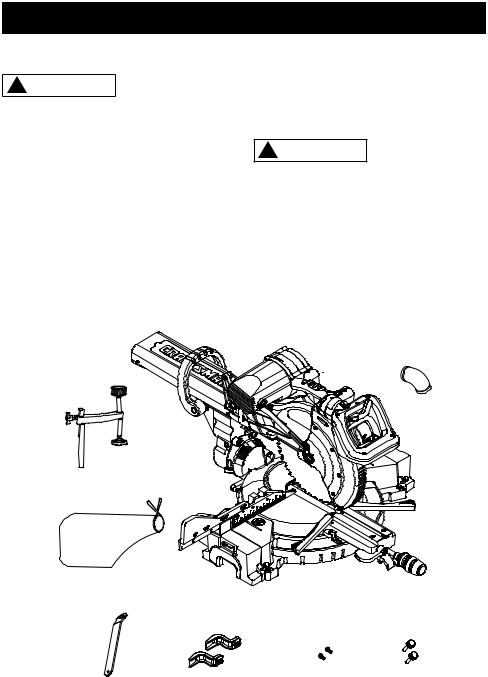
CARTON CONTENTS
UNPACKING YOUR MITER SAW
! WARNING
To avoid injury from unexpected starting or electrical shock, do not plug the power cord into a source of power during unpacking and assembly. This cord must remain unplugged whenever you are working on the saw.
1.Remove the miter saw from the carton.
IMPORTANT: Do not lift miter saw by the trigger switch handle. It may cause misalignment. Lift machine by the built-in carry handle.
2.Place the saw on a secure stationary work surface.
Hold-down clamp
Dust bag
Blade wrench |
Power cord |
|
storage clips |
||
|
3.Separate all parts from the packing material. Check each one with the illustration to make certain all items are accounted for, before discarding any packing material.
! WARNING
If any part is missing or damaged, do not attempt to assemble the miter saw, or plug in the power cord until the missing or damaged part is correctly replaced. To avoid electric shock, use only identical replacement parts when servicing double insulated tools. Call 1-800-4-MY-HOME® for replacement parts.
Elbow
Miter saw
Power cord |
Hold-down clamp |
|
storage clip |
||
lock knob |
||
mounting |
||
|
||
hardware |
|
 13
13 

KNOW YOUR SLIDING MITER SAW
Carry handle |
Upper blade guard |
|
|
|
Carry handle Laser ON/OFF switch |
Motor |
|
Handle locking lever |
|
Switch handle |
|
|
|
|
Saw blade |
|
ON/OFF trigger switch |
|
|
|
Bevel scale |
|
Lower blade guard |
|
|
|
Hold-down clamp |
|
Base |
Sliding fence |
|
Miter lock handle |
|
|
|
Left extension table |
|
Bevel lock handle |
|
|
|
Turntable |
Mounting hole Left support |
|
Hold-down latch
Slide carriage
|
|
Slide carriage |
Belt cover |
|
lock knob |
|
|
|
|
|
Laser guide |
|
|
Right extension table |
|
|
Stop plate |
Quick-cam miter |
Table insert |
Right support |
table lock |
Positive miter detents |
|
|
|
 14
14 

GLOSSARY OF TERMS
AMPERAGE (AMPS) – A measure of the flow of electric current. Higher ratings generally means the tool is suited for heavier use.
ARBOR LOCK – Allows the user to keep the blade from rotating while tightening or loosening the arbor bolt during blade replacement or removal.
BASE – Supports the table, holds accessories and allows for workbench or leg set mounting.
BEVEL LOCKING HANDLE – Locks the miter saw at a desired bevel angle.
BEVEL SCALE – To measure the bevel angle of the saw blade 0° to 45° left.
CARBIDE TIPPED – Extremely hard steel pieces with sharp cutting edges fastened to cutting tools such as saw blades.
COVER PLATE SCREW – Loosen this screw and rotate the plate for access to the blade arbor bolt.
DOUBLE-INSULATED – A form of electrical protection featuring two separate insulation systems to help protect against electrical shock.
EXTENSION CORD – An electric cord used between power tools and outlets to extend the range of the tools. The more amerage your tool uses, the longer the distance, the larger the size of the wire needed in your extension cord.
EYE PROTECTION – Googles or spectacles intended to protect your
eyes. Eye protection should meet the requirements of ANSI Z.87.1 (USA) or CSA Z94.3-M88 (Canada).
FACE SHIELD – An impact resistant shield that helps to protect your face from chips, sparks, small debris.
Should only be used in conjunction with additional eye protection.
FENCE – Helps to keep the workpiece from moving when sawing. Scaled to assist with accurate cutting.
GUARD – Protective devise that forms a barrier between a hazardous object such as a blade, wheel or cutter and the operator.
HOLD DOWN LATCH – Locks the miter saw in the lowered position for compact storage and transportation.
INSTRUCTION OR OPERATOR’S MANUAL – Booklet accompanying your power tool that describes the hazards and safe operation procedures, outlines basic tool operation, care and maintenance.
MITER HANDLE – Used to rotate the table, and to rotate the saw to a right or left cutting position.
MITER SCALE – Measures the miter angle 0° to 45° left and right.
MOUNTING HOLES – To mount the miter saw to a stable surface.
ON/OFF TRIGGER SWITCH – To start the tool, push the safety lock-off button and squeeze the trigger. Release the trigger to turn off the miter saw.
 15
15 
POSITIVE STOP LOCKING LEVER –
Locks the miter saw at a preset positive stop for the desired miter angle.
SWITCH HANDLE – The switch handle contains the trigger switch and safety lock-off button. The blade is lowered into the workpiece by pushing down on the handle. The saw will return to its upright position when the handle is released.
WARNING LABELS – Read and understand for your own safety. Make sure all labels are present on machine and legible.
WRENCH STORAGE – Convenient storage to prevent misplacing the blade wrench.
WOODWORKING TERMS
ARBOR – The shaft on which a blade is mounted.
BEVEL CUT – An angle cut made through the face of the workpiece.
COMPOUND CUT – An angled cut to both the edge and face of a board, most common use is with crown molding.
CROSS CUT – A cut which runs across the board perpendicular to the grain.
FREEHAND – Performing a cut without using a fence (guide), hold down or other proper device to prevent the workpiece from twisting during the cutting operation.
HEEL – Misalignment of the blade.
KERF – The width of a saw cut, determined by the thickness and set of the blade.
KICKBACK – Sudden and unintended movement of the tool or workpiece. It is typically caused by binding or pinching of the workpiece
MITER CUT – A miter is a type of joint where the two parts to be joined are cut at an angle, and typically the finished joint forms a 90-degree angle. Also commonly spelled “mitre”.
REVOLUTIONS PER MINUTE (RPM)
– The number of turns completed by a spinning object in one minute.
SAW BLADE PATH – The area of the workpiece or table top directly in line with the travel of the blade or the part of the workpiece which will be cut.
SET – The distance between two saw blade tips, bent outward in opposite directions to each other. The further apart the tips are, the greater the set.
THIN-KERF BLADE – Thinner than normal blades, remove less material, smaller kerfs (between .065 and .070). Blade thinness also may increase the heat generated while cutting.
WORKPIECE – The wood being cut. The surfaces of a workpiece are commonly referred to as faces, ends and edges.
 16
16 
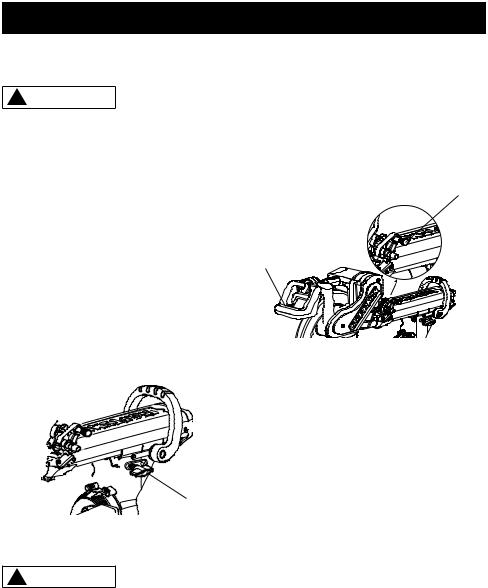
ASSEMBLY AND ADJUSTMENTS
ESTIMATED ASSEMBLY TIME: 10~15 MINUTES
! WARNING
To avoid injury, do not connect this miter saw to the power source until it is completely assembled and adjusted, and you have read and understood this Operator’s Manual.
UNLOCKING THE SLIDE CARRIAGE (FIG. A)
After removing the saw from the carton, loosen the slide carriage lock knob
(1). When transporting or storing the miter saw, the slide carriage should always be locked in position. The slide carriage lock knob (1) is located on the right side of the slide carriage.
Fig. A
1
RELEASING CUTTING HEAD (FIG. B)
! WARNING
To avoid injury and damage to the saw, transport or store the miter saw with the cutting head locked in the down position. Never use the hold down latch to hold the cutting head in a down position for cutting operations.
Unlocking
1.Push down slightly on the switch handle (1).
2.Pull out the hold-down latch (2).
3.Allow the cutting head to rise to the up position.
Fig. B
2
1
Locking
When transporting or storing the miter saw, the cutting head should always be locked in the down position.
1.Push the cutting head down to its lowest position.
2.Push the hold-down latch (2) into the locking hole.
IMPORTANT: To avoid damage, never carry the miter saw by the switch handle, the cutting arm or the miter handle. ALWAYS use the designated carrying handles located on the top of the machine and in the back of the unit.
 17
17 
